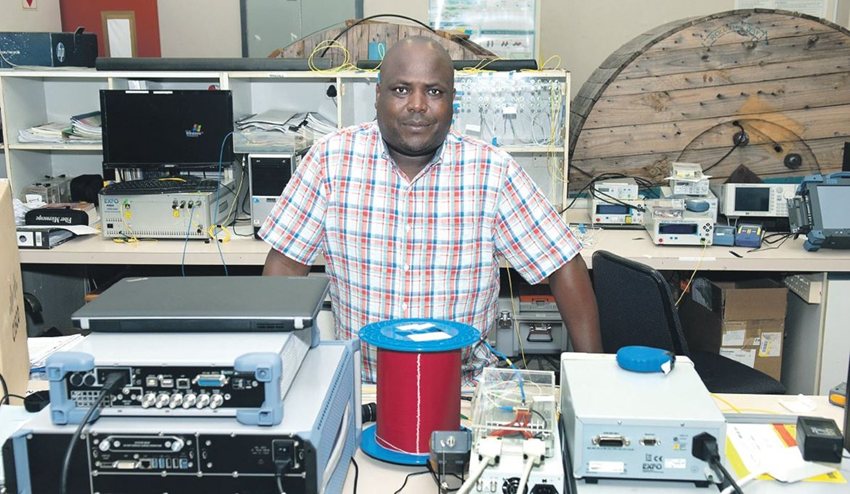SA’s leading physicists are developing new optical fibre technology to ensure that all South Africans are connected to the internet by 2020. The future of our internet is being designed in the basement of the physics building at the Nelson Mandela Metropolitan University in Port Elizabeth.

Here, in the Centre for Broadband Communication, leading physicists are developing new optical fibre technology that will be able to send and receive vast amounts of data.
To give you an idea of the speed of the internet connectivity the research team at the centre is working with, you could download a CD or DVD in less than a second.
This is where I meet Dr Valentine Chabata, who graduated with a PhD in physics from Nelson Mandela Metropolitan University last month. His PhD research, funded by the African Laser Centre, was on the use of light to transfer and receive big data.
“I succeeded in my objective, and managed to transmit and receive 20 gigabits per second over hundreds of kilometres,” says Chabata, who is the centre’s first PhD graduate.
He was supervised by its director, Professor Tim Gibbon.
The technology will be used by the world’s largest radio frequency telescope, the Square Kilometre Array, and its precursor, MeerKAT, in the Northern Cape.
But even you and I will use it because an equally important goal of the centre is to ensure the technology connects all South Africans to the internet by 2020, which is what government has promised.
It’s all happening in this state-of-the-art research facility, which is funded by the department of science and technology, the CSIR, and leading international and local industry players, notably Cisco, Telkom, Dartcom and Lambda Test Equipment.
Here, you will find a laboratory strewn with electronics, wires and outsized reels of optical fibre cable. Students and researchers work on impossibly complex physics problems night and day. Their lifelines: a coffee machine and a microwave.
The centre was established in 2015 and grew out of the Optical Fibre Research Unit at Nelson Mandela Metropolitan University, which produced several master’s and a PhD graduate.
“Light is complex and intriguing, and there is so much we still need to understand about it. Sometimes it behaves like a particle and sometimes like a wave. Its dual nature has puzzled scientists and philosophers for centuries,” says Chabata, who is a physics lecturer at the National University of Science and Technology in Bulawayo, Zimbabwe.
Gibbon says: “The research that Chabata has done is critical for our preparatory research on advanced modulation formats, where we are looking at methods of encoding data signals into a light wave in unique ways.”
The bandwidth will enable scientists to seek and retrieve information from our universe by looking back in space and time over billions of years. It will also help create a more emancipated society by developing the technology required for facilities such as eLearning in every school in South Africa, including in deeply rural areas.
It will enable other critical functions, such as eHealth, where nurses, doctors and health workers countrywide and internationally will be able to diagnose and discuss health issues online. This will help to address the severe shortage of doctors and specialists that we face in Africa, because the remotest rural clinics will be able to conduct video consultations with specialists from the patient’s bedside.
“In Africa, we have lots of challenges, from telecommunications to basic issues like securing food and water,” says Chabata, adding that his PhD has provided the tools to tackle the challenges in various fields.
“I supervise postgraduates at my university, and develop course material for undergraduate and postgraduate studies in optical communications.”
While his home country has a number of physicists, he is the only specialist in optical fibre.
Doing his doctorate meant being away from home for three years, and not seeing his family. At the age of 44, this meant Chabata and his wife, Stella, had to make sacrifices.
They have been married since 2000 and have three children, two girls and a boy, aged 16, 10 and four.
Chabata says: “I am so grateful to Stella because she had to be mother and father, and run the home while I was away.
“Fortunately, we have the internet and Skype, so we could speak to and message each other.”
Stella studied fashion and fabrics at the National University of Science and Technology and is currently teaching at a secondary school in Bulawayo while doing her master’s in textile studies.
Although he has a qualification that can take him anywhere in the world, Chabata remains committed to Zimbabwe.
Gibbon says they will be extending the relationship with Chabata and his students.
“Several scholars from African universities come to the centre because they don’t have these facilities at their universities. It is important for us to help grow physics skills on the continent.”